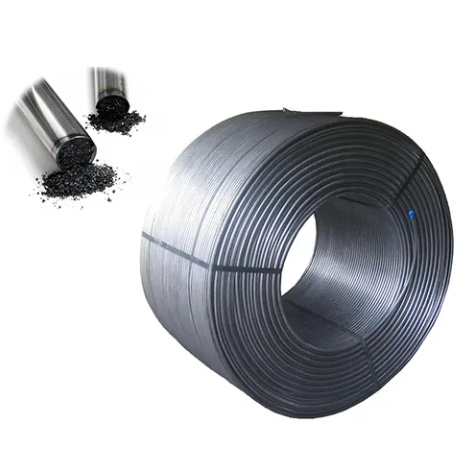
In iron and smelting enterprises, pure calcium cored copper wire is used for the treatment of molten smelting steel. The purpose of using this wire is to reduce the harmful content of molten metal, to change the composition, to prevent nozzle clogging, and to improve the casting performance.
The technology uses high-quality steel sheaths filled with calcium dust to achieve a desired core density. The ratio of the sheath's thickness to the powder content is 4x greater than for conventional calcium-cored wires. And, the metallurgical performances are significantly better. The cored wire can be fed by existing equipment in electric-arc furnaces and ladle metalurgical plants. The process eliminates the need for a specialized injection system. This reduces costs, and eliminates additional consumables and equipment.
When a cored steel wire is injected into a molten bath, the temperature distribution on the surface of the slag around the shell increases gradually while that on the core decreases. The metallurgical data obtained from simulations and experiments indicate that the sheath melts more slowly and releases the calcium powder faster than the steel core. This is due to the different melting thermodynamics between solid calcium and molten iron. The temperature distribution of a cored steel wire has a fish-scale pattern, with a peak at the front and an average value toward the tail end.
It is difficult for a conventional cored-wire calcium treatment to be implemented because the evaporation slag causes contamination of molten metal. This leads to poor casting purity and reduced mechanical strength. The low melting points of calcium make it difficult to reach deeper and upper positions in molten iron, where they are needed for the desulfurization process.

LSFerroalloy’s Calcium Cored Wire, on the contrary, can penetrate deeper in the molten steel and react with it better. The result is higher calcium yields in the finished product, and less contamination of the molten material. In addition, the calcium is released more quickly into the molten metal, enabling it to reach its intended destination in the slag phase more easily. The improved performance is also a factor in better inclusion modification of molten steel. This makes it easier to produce high-quality castings with superior mechanical properties. The advantages of the new technology are obvious: higher calcium yield, reduced contaminants in molten metal and castings, improved steel casting performance and cost savings at the mill. All of this contributes significantly to the profitability in the iron and steel industries.

Write a Message